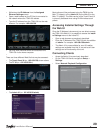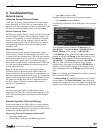
37
Installation Manual
CHAPTER 5
5. Troubleshooting
Network Issues
Using the Correct Ethernet Cables
There are two types of network cables that may be used
when connecting the TGM-100 to a home network. It is
important that the correct type of cable is used or the TGM-
100 may fail to communicate properly with the network.
Ethernet Crossover Cable
An Ethernet crossover cable is usually used to connect two
devices together directly, without employing a switch, hub
or router in the network. If you are connecting a computer
directly to the TGM-100 (for example, you may need to
connect a laptop to the TGM-100 temporarily to confi gure
settings during installation) then you will need to use a
crossover cable.
Ethernet Patch Cable
Sometimes known as a straight through cable, a patch
cable is usually used to connect devices to a switch, hub
or router. If you are connecting the TGM-100 to an existing
network via a network device, such as an Ethernet switch,
you should used a patch cable. If you are confi guring a
new network and connecting computers and the TGM-100
to it, use patch cables between the various components
and the network device.
Note: If you are unsure if you have a patch cable or
crossover cable, examine the wires visible through the
plugs at either end. On a patch cable, the confi guration of
the wires should be identical at both ends. On a crossover
cable the wire confi guration will be slightly different (usually
the green and orange wires will be in opposite positions).
If you are unsure, contact the network administrator or
consult an IT professional.
Cat5e/Cat6
It is important to use Cat5e or Cat6 Ethenet cables
throughout the TGM-100's network when installing a TGM-
HDC. Utilizing other types of cabling can cause improper
operation.
Determining Static Ethernet Settings
If you are connecting the TGM-100 to an existing network
and you want to confi gure Static Ethernet settings you will
need to discover the settings of a computer on the network
to determine the IP range of the network.
Discovering Ethernet Settings on a Windows PC
Click on the • Start button.
Click on• Run... to bring up the Run dialogue box.
Type • cmd and click on OK.
A window will open containing the command prompt.
Type • ipconfi g and press Enter.
The following information will be displayed in the command
window:
The information above shows the IP Address to be
192.168.250.1. The Subnet Mask is 255.255.255.0 and
Default Gateway of the network is 192.168.250.1.
The IP Address of the TGM-100 will need to be a unique
address in the same IP Range as the other devices. The
IP Address of the computer in the above example is
192.168.250.1. The IP Range is therefore 192.168.250.1-
254. The TGM-100 can be confi gured to any unused
address within this range (for example, 192.168.250.3). If
possible, check the other devices on the network to see
which addresses within the IP Range are already being
used.
Note: Do not assign an IP Address that is within the range
of the network's DHCP server.
The Subnet Mask will usually be the same for all devices
on the network. The Default Gateway is also likely to be
the same for all devices and in most cases will also be the
address of the DNS server when confi guring the TGM-100.


















